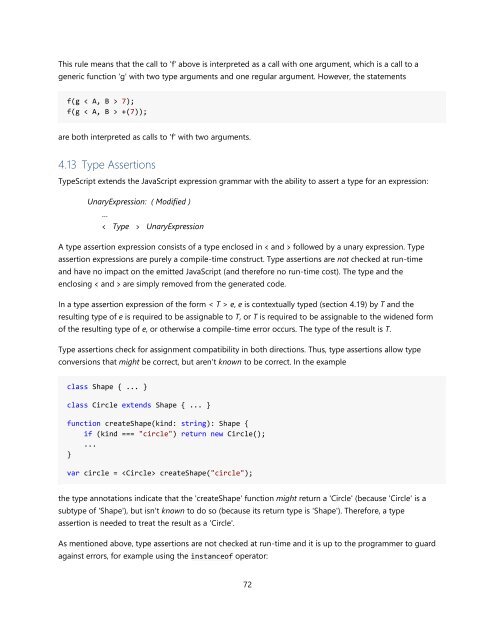TypeScript Language Specification v1.5
TypeScript Language Specification v1.5
TypeScript Language Specification v1.5
Create successful ePaper yourself
Turn your PDF publications into a flip-book with our unique Google optimized e-Paper software.
This rule means that the call to 'f' above is interpreted as a call with one argument, which is a call to a<br />
generic function 'g' with two type arguments and one regular argument. However, the statements<br />
f(g < A, B > 7);<br />
f(g < A, B > +(7));<br />
are both interpreted as calls to 'f' with two arguments.<br />
4.13 Type Assertions<br />
<strong>TypeScript</strong> extends the JavaScript expression grammar with the ability to assert a type for an expression:<br />
UnaryExpression: ( Modified )<br />
…<br />
< Type > UnaryExpression<br />
A type assertion expression consists of a type enclosed in < and > followed by a unary expression. Type<br />
assertion expressions are purely a compile-time construct. Type assertions are not checked at run-time<br />
and have no impact on the emitted JavaScript (and therefore no run-time cost). The type and the<br />
enclosing < and > are simply removed from the generated code.<br />
In a type assertion expression of the form < T > e, e is contextually typed (section 4.19) by T and the<br />
resulting type of e is required to be assignable to T, or T is required to be assignable to the widened form<br />
of the resulting type of e, or otherwise a compile-time error occurs. The type of the result is T.<br />
Type assertions check for assignment compatibility in both directions. Thus, type assertions allow type<br />
conversions that might be correct, but aren't known to be correct. In the example<br />
class Shape { ... }<br />
class Circle extends Shape { ... }<br />
function createShape(kind: string): Shape {<br />
if (kind === "circle") return new Circle();<br />
...<br />
}<br />
var circle = createShape("circle");<br />
the type annotations indicate that the 'createShape' function might return a 'Circle' (because 'Circle' is a<br />
subtype of 'Shape'), but isn't known to do so (because its return type is 'Shape'). Therefore, a type<br />
assertion is needed to treat the result as a 'Circle'.<br />
As mentioned above, type assertions are not checked at run-time and it is up to the programmer to guard<br />
against errors, for example using the instanceof operator:<br />
72


















